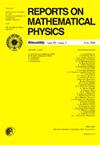2 × l和Sol3上的Riemann孤子
IF 1.2
4区 物理与天体物理
Q3 PHYSICS, MATHEMATICAL
引用次数: 0
摘要
本文研究了具有左不变黎曼度量的李群& Hopf;2 × l和Sol3,并研究了它们上的黎曼孤子。我们证明了李群&;Hopf;2 ×∈允许黎曼孤子,而李群Sol3不允许黎曼孤子。我们对李群上的所有黎曼孤子进行了分类,并展示了黎曼孤子的哪些势向量场是杀戮场、里奇共向场和里奇双共形向量场。同时,我们对李群Sol3上所有Ricci双共形向量场进行了分类,并给出了其中哪些是杀戮和Ricci共视。本文章由计算机程序翻译,如有差异,请以英文原文为准。
Riemann Solitons on ℍ2 × ℝ and Sol3
In this paper, we consider the Lie groups ℍ2 × ℝ and Sol3 with left-invariant Riemannian metrics and we study the Riemann solitons on them. We prove that the Lie group ℍ2 × ℝ admits the Riemann soliton and the Lie group Sol3 does not admit the Riemann soliton. We classify all Riemann solitons on the Lie group ℍ2 × ℝ and we show which of the potential vector fields of Riemann solitons are Killing, Ricci collineation, and Ricci bi-conformal vector fields. Also, we classify all Ricci bi-conformal vector fields on the Lie group Sol3 and we show which of them are Killing and Ricci collineation.
求助全文
通过发布文献求助,成功后即可免费获取论文全文。
去求助
来源期刊

Reports on Mathematical Physics
物理-物理:数学物理
CiteScore
1.80
自引率
0.00%
发文量
40
审稿时长
6 months
期刊介绍:
Reports on Mathematical Physics publish papers in theoretical physics which present a rigorous mathematical approach to problems of quantum and classical mechanics and field theories, relativity and gravitation, statistical physics, thermodynamics, mathematical foundations of physical theories, etc. Preferred are papers using modern methods of functional analysis, probability theory, differential geometry, algebra and mathematical logic. Papers without direct connection with physics will not be accepted. Manuscripts should be concise, but possibly complete in presentation and discussion, to be comprehensible not only for mathematicians, but also for mathematically oriented theoretical physicists. All papers should describe original work and be written in English.
 求助内容:
求助内容: 应助结果提醒方式:
应助结果提醒方式:


